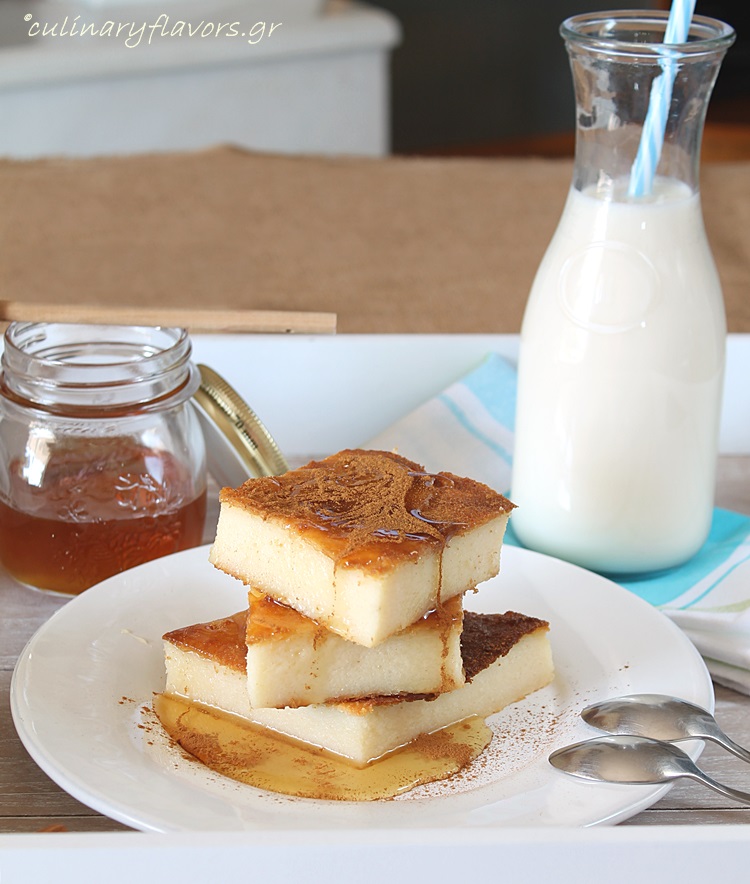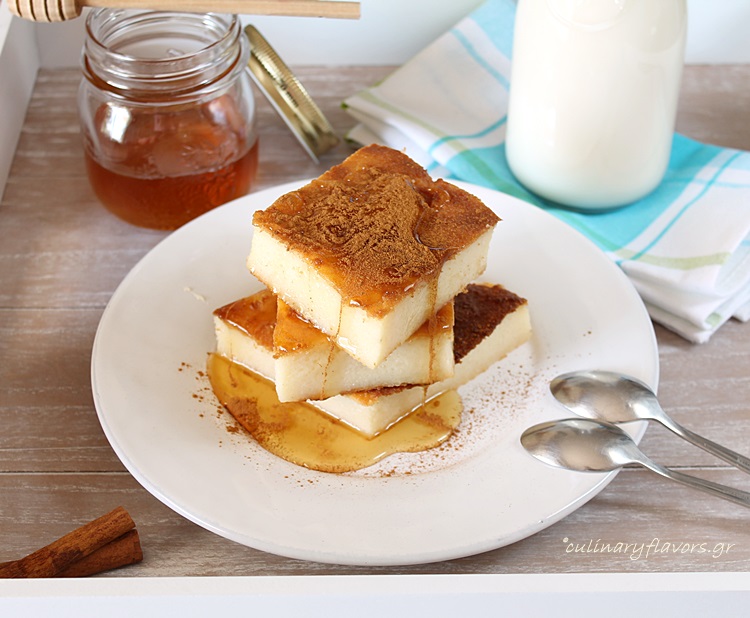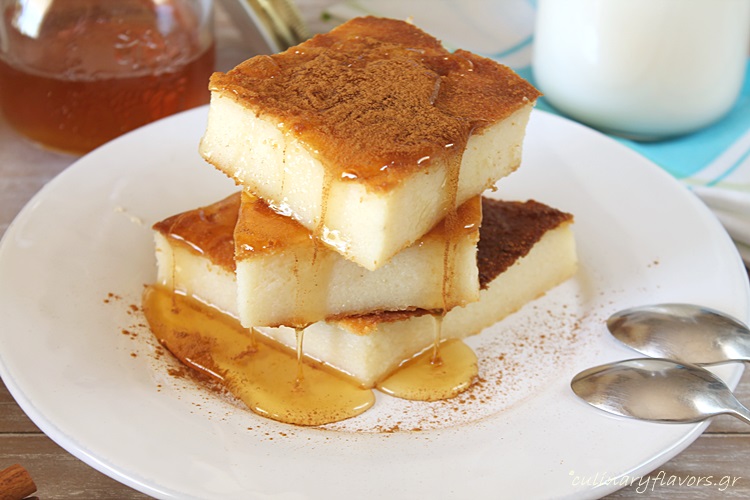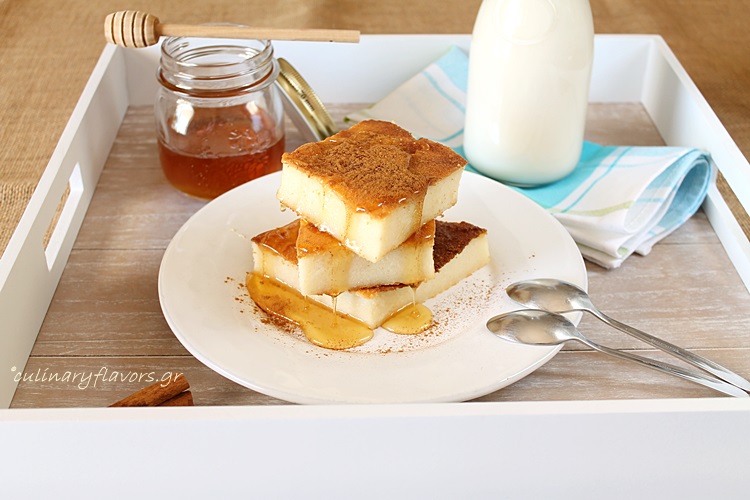Pies are an inextricable part of Greek diet from the old times. Since ancient years, Greek economy was based heavily on farming, stock breeding and fishing. Since the country’s topography is mountainous, one can easily understand that sheep and goats were the main source of feed and income.
Back in the old days, people had flocks consisting of hundreds of animals and they were producing milk, cheese, butter, leather and meat. In those societies, just like in feudalistic Europe, people very rarely did they have the chance to exchange goods for money. So, they usually traded the goods they produced with other goods they lacked.
Because of the changes in the weather conditions they had to move their flocks in order to find food. Those long months of absence, they tried to cook in the open air and with very basic vessels. Pies without phyllo were a great choice, not only because they were easy to make, but also because they could use ingredients they had handy.
Milk pie or Galatópita, as it is called in Greek, was a very basic and common crust less pie. Milk they had abundant from the sheep and goats and as a cooking means they used a vessel that was light and easy to carry and could be placed directly on fire without burning. Those milk pies were very simple, using milk, flour and perhaps cheese. As years passed by and other wheat products started to make their appearance, semolina replaced flour and gave this pie a light and airy texture. Eggs also were included making the final result fluffier and more tasty.
Trying to give your child a school snack is really a pain in the neck. Sometimes, I find it more difficult than deciding what to cook. You have to take into consideration so many constraints that make the whole procedure quite a challenge.
For two months now, I was giving my son several types of cakes (you can check in this blog for their recipes) and I felt that he got bored because lately he brought the cake intact back home. So, I was trying to think what I could give him as a sweet snack at school and Galatópita came to my mind. It is perfect as a school snack because it is carried very easily, it is solid, it can be eaten at room temperature and is quite resistant to cold or hot temperatures. It is also perfect for breakfast, brunch or as an afternoon sweet bite. If you cannot find mastic you may as well omit it. You can add lemon or orange extracts which are fine too.
- 1lt / 2 pints full fat milk
- 1 cup coarse grain semolina (you can use fine grain semolina without a problem
- 1 ¼ cup sugar
- 2 eggs
- 2 gr. / ⅛ tsp mastic powder or you can use 1 tsp of vanilla extract or ¼ tsp lemon or orange extract
- 1 tbsp butter
- Honey and cinnamon for garnish
- Preheat oven to 175°C / 350°F.
- In a bowl mix the eggs, half of sugar and mastic or extract and set aside.
- In a deep pot pour the milk, the rest half of sugar and butter and bring to boil.
- Add the semolina and whisk vigorously to incorporate.
- When the batter becomes thick, remove from stove and add the eggs/sugar batter and continue to whisk until they are all incorporated.
- Take a rectangular pan about 30cm X 21 cm. / 11 in. X 8 in. and butter it very well.
- Pour the mixture to the pan and bake for 40 to 45 minutes.
- Remove, loosen the sides and let it cool for 15 minutes.
- Cut squared pieces, pour some honey and sprinkle some cinnamon and serve.
- 1 λίτρο γάλα
- 1 φλ. σιμιγδάλι χονδρό (μπορείτε να χρησιμοποιήσετε και λεπτό χωρίς πρόβλημα)
- 1 ¼ φλ. ζάχαρη
- 2 αυγά
- 2 γρ. μαστίχα σε σκόνη ή μπορείτε να χρησιμοποιήσετε 1 κ.γ. εκχύλισμα βανίλιας ή ¼ κ.γ. εκχύλισμα λεμονιού ή πορτοκαλιού
- 2 βανιλλίνες
- 1 κ.σ. βούτυρο
- Μέλι και κανέλα για το γαρνίρισμα
- Προθερμαίνετε το φούρνο στους 175° C.
- Σε ένα μπολ ανακατεύετε τα αυγά, τη μισή από την ζάχαρη και τη μαστίχα ή το εκχύλισμα λεμονιού ή πορτοκαλιού και αφήστε στην άκρη.
- Σε μια βαθιά κατσαρόλα ρίξτε το γάλα, το υπόλοιπο μισό από τη ζάχαρη και το βούτυρο και φέρτε σε βρασμό.
- Προσθέστε το σιμιγδάλι και ανακατέψτε ζωηρά να ενσωματωθούν.
- Όταν το μίγμα πήξει, βγάλτε το από τη φωτιά και προσθέστε το μίγμα αυγών/ζάχαρης και συνεχίστε το ανακάτεμα μέχρι να ενσωματωθούν.
- Πάρτε ένα ορθογώνιο ταψί περίπου 30 cm X 21 cm. και βουτυρώστε το πολύ καλά.
- Ρίξτε το μίγμα στο ταψί και ψήστε για 40-45 λεπτά.
- Βγάλτε το από το φούρνο, χαλαρώστε τις πλευρές και αφήστε το να κρυώσει για 15 λεπτά.
- Κόψτε τετράγωνα κομμάτια, ρίξτε λίγο μέλι και κανέλα και σερβίρετε.




